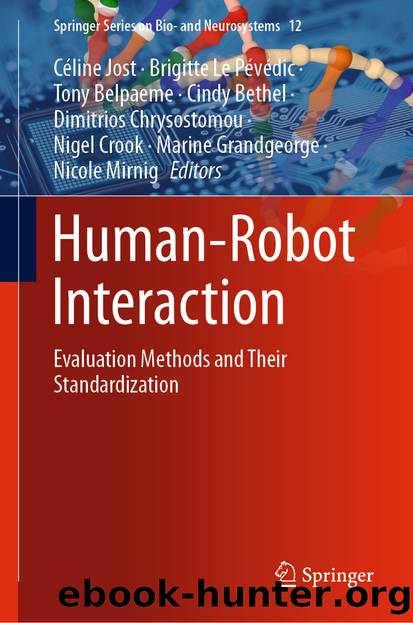Human-Robot Interaction by Unknown

Author:Unknown
Language: eng
Format: epub
ISBN: 9783030423070
Publisher: Springer International Publishing
6 Conclusions
This chapter presents the basics associated with using a forensic structured interview approach for gathering richer data from human-robot interaction studies. Although survey and self-assessment data is a place to start and is useful in human-robot interaction studies, the content is limited. Study participants are forced to provide information associated only with what information is requested based on the items selected by the researcher. This type of data can only provide a certain amount of information about interactions between robots and humans.
In order to obtain additional information from participants of user studies, it is recommended that researchers enhance studies through the use of structured or semi-structured interview questions. This allows participants of the study to provide their own insights and feelings regarding the interactions and gives an opportunity for them to provide additional knowledge and insight. This type of data can be challenging, time intensive, and tedious to evaluate; however, it can provide additional insights that may not be discerned using other methods of evaluation.
As discussed in the Related Work Sect. 2, there are many different types of interview techniques that can be used. The focus of this chapter was on the use of an investigative interview technique, known as the forensic interview [9]. This approach has been successfully used in different types of investigations and it is especially effective for use in studies involving children. The approach for using the forensic interview protocol were presented in Sect. 3 and included the introduction, guidelines, rapport building, narrative practice, substantive disclosure, and cool-down/wrap-up techniques. A discussion on the process of transcription and coding of the qualitative data was presented in Sect. 4. An exemplar study was presented to help reinforce and demonstrate the process of how to conduct a forensic interview, and then examples of the how the transcription, coding, and analyses process was performed for this type of study. Although the process of using structured interviews with open-ended types of questions seems to incur significant effort, the results may transform human-robot interaction research and researchers are encouraged to consider using this approach in the design of their studies.
References
1.
Baxter, P., Kennedy, J., Senft, E., Lemaignan, S., Belpaeme, T.: From characterising three years of hri to methodology and reporting recommendations. In: The Eleventh ACM/IEEE International Conference on Human-Robot Interaction, pp. 391–398. IEEE Press (2016)
Download
This site does not store any files on its server. We only index and link to content provided by other sites. Please contact the content providers to delete copyright contents if any and email us, we'll remove relevant links or contents immediately.
| Automotive | Engineering |
| Transportation |
Whiskies Galore by Ian Buxton(41941)
Introduction to Aircraft Design (Cambridge Aerospace Series) by John P. Fielding(33095)
Small Unmanned Fixed-wing Aircraft Design by Andrew J. Keane Andras Sobester James P. Scanlan & András Sóbester & James P. Scanlan(32767)
Craft Beer for the Homebrewer by Michael Agnew(18200)
Turbulence by E. J. Noyes(7983)
The Complete Stick Figure Physics Tutorials by Allen Sarah(7339)
Kaplan MCAT General Chemistry Review by Kaplan(6904)
The Thirst by Nesbo Jo(6882)
Bad Blood by John Carreyrou(6586)
Modelling of Convective Heat and Mass Transfer in Rotating Flows by Igor V. Shevchuk(6408)
Learning SQL by Alan Beaulieu(6240)
Weapons of Math Destruction by Cathy O'Neil(6221)
Man-made Catastrophes and Risk Information Concealment by Dmitry Chernov & Didier Sornette(5958)
Digital Minimalism by Cal Newport;(5712)
Life 3.0: Being Human in the Age of Artificial Intelligence by Tegmark Max(5520)
iGen by Jean M. Twenge(5387)
Secrets of Antigravity Propulsion: Tesla, UFOs, and Classified Aerospace Technology by Ph.D. Paul A. Laviolette(5338)
Design of Trajectory Optimization Approach for Space Maneuver Vehicle Skip Entry Problems by Runqi Chai & Al Savvaris & Antonios Tsourdos & Senchun Chai(5040)
Pale Blue Dot by Carl Sagan(4961)
